How Electron Spin is Ushering in a New Era of Ultra-Efficient, Brain-Inspired, and Quantum-Ready Computing
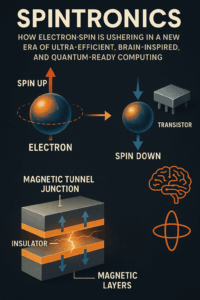
Spintronics uses electron spin rather than charge to store and process data, enabling ultra-efficient and quantum-friendly computing.
For decades, all our computers and gadgets have relied on moving electric charge to process data – but a new approach is emerging that taps a different property of electrons. Instead of (or in addition to) charge, spintronics exploits each electron’s intrinsic spin – its tiny magnetic moment that can point “up” or “down” like a miniature compass needle. In a spintronic device, a bit can be encoded by an electron’s spin orientation rather than by shuffling charge through a circuit. This subtle shift has huge implications: because flipping a spin doesn’t require physically moving electrons, spin-based circuits can use far less energy and generate less heat. In other words, spintronics promises faster, cooler computing.
More Than Charge: How Spintronics Works
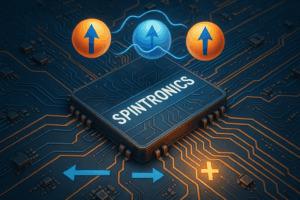
Visualization of how spintronics utilizes electron spin—beyond electric charge—to process and store information on a nanoscale chip.
In traditional electronics, a binary 1 or 0 is stored by the presence or absence of electric charge. Spintronics adds the electron’s spin as another data handle. An electron’s spin can be “up” or “down” (or, in quantum physics, even both at once), acting like a tiny bar magnet. A helpful analogy: imagine each electron as a tiny compass whose needle can point north or south. By setting these magnetic needles up or down, a spintronics device can represent bits just like voltages do in a normal chip – but without the need to push the electrons around. As one physics summary notes, this means “Spintronics … doesn’t require moving electrons around when a 1 is changed to a 0, so it requires less energy”. In practice, spin is linked to magnetism: devices use magnetic layers and fields to “write” and “read” the spin state.
A key building block is the Magnetic Tunnel Junction (MTJ) – essentially a sandwich of two ultra-thin magnetic layers separated by a roughly 1-nanometer insulator. If the magnetic layers’ spins align in the same direction, electrons can quantum-tunnel through the barrier (low resistance), representing a binary “0.” If the layers’ spins are opposite, the tunnel is effectively “closed” (high resistance), giving a “1.” Crucially, this configuration is non-volatile: once set, the spins stay put even without power, so the device “remembers” its bit until actively flipped. The MTJ was first used in hard-disk drive read heads in the 1990s, and now forms the heart of MRAM (magnetoresistive random-access memory) chips.
Importantly, shrinking CMOS transistors now runs into a quantum barrier: when the gate oxide reaches ≈1 nm thickness, electrons begin to leak through by quantum tunneling, and chips lose energy as heat. Ironically, MTJ-based spintronics leverages that same tunneling effect. Instead of fighting leakage, electrons intentionally tunnel through the barrier, with the probability controlled by spin alignment. The thinner the barrier, the stronger the tunneling – so spintronic devices actually improve as feature sizes shrink, making them well suited for future sub-nanometer technologies.
Merging Memory and Compute
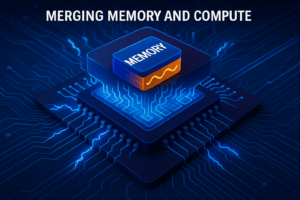
Visualizing the fusion of memory and logic within a single chip—an innovation enabled by spintronics that dramatically boosts speed and efficiency.
Another big advantage of spintronics is its natural combination of storage and processing. Today’s computers follow the “von Neumann” architecture where memory (RAM, storage) is separate from the CPU. Every calculation forces data to shuttle back and forth between chips, burning time and power. By contrast, our own brains store memories and process information in the same neurons and synapses, which is why we can think almost instantaneously. Spintronic devices offer a path to copy that brain-inspired model. Because an MTJ both stores a bit and can modulate current, grids of MTJs can perform in-memory computing. For example, a small crossbar of MTJs can hold a matrix of “weights” (encoded by spin states) while input voltages are applied row by row. Currents sum up in the columns, naturally computing multiply-and-accumulate operations in one analog step. In short, a neural-network-style dot-product happens right where the data lives, with no energy wasted moving bits around. This has been shown to execute key AI math far faster and more efficiently than charge-based logic.
Indeed, recent experiments confirm the promise: researchers built multi-level spintronic “synapse” devices whose spin states directly represent analog weights. In one study, a special MTJ design achieved 11 stable memory levels (not just 0/1) under purely electrical control, perfectly mimicking how a biological synapse strengthens or weakens. When those devices were plugged into an image-recognition neural network (a variant of ResNet), the network’s accuracy was virtually unchanged – about 81.5% correctness, matching the original model. This demonstrates that complex brain-like computing can run on spintronic hardware: the result was “faster and more compact” systems that use far less energy than conventional circuits.
Beyond Deterministic Logic: Probabilistic and Neuromorphic Modes
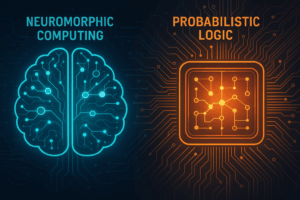
Visual contrast of neuromorphic computing and probabilistic logic—the future paths beyond deterministic silicon, powered by emerging spintronic technologies.
Spintronics also opens doors to entirely new computing styles. For example, because MTJs can be designed to switch stochastically, researchers are exploring probabilistic computing. Here, random fluctuations aren’t bugs but features: circuits literally harness thermal noise or quantum randomness to solve problems like optimization or sampling, much like quantum annealers or brain-inspired models do. Imagine a chip that finds the shortest route for an Uber by naturally trying many paths at once, driven by random spins settling into low-energy patterns. Early work suggests spin-based probabilistic units could accelerate such tasks.
Even more speculatively, chaotic or dynamical computing schemes could use spins’ complex behavior (oscillations, domain walls, etc.) as computation units. In all these cases, the fact that spintronic devices are inherently fast (switching in picoseconds) and nonvolatile gives them an advantage: they can iterate many possibilities quickly without power-hungry memory refreshes. In short, spintronics doesn’t just promise a faster laptop – it hints at completely new computer architectures that blur the lines between memory, logic, analog, and even random processing.
Spinning Towards Quantum Computing
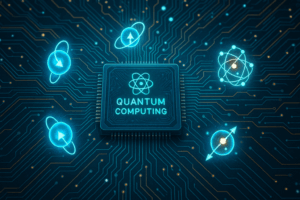
A visionary depiction of quantum computing empowered by spintronics—where electron spin states evolve into quantum bits, shaping the future of computation.
Since electron spin is inherently a quantum property, spintronics overlaps with quantum computing. In fact, “spin qubits” – where a qubit is encoded in an electron’s spin – are among the most promising routes to scalable quantum chips. Intel, for example, has built a 12-qubit research chip called Tunnel Falls that encodes each qubit as the up/down spin of a single electron in a silicon quantum dot. Because these spin qubits can be fabricated on standard silicon wafers using similar processes as today’s transistors, they inherit the maturity and precision of the semiconductor industry. Intel points out that silicon spin qubit devices can be ~50 nm wide – roughly a million times smaller than many other qubit types – suggesting they could scale to large arrays. In short, spin-based quantum bits may combine the “best of both worlds”: quantum superposition for powerful new algorithms, and the familiar, high-volume manufacturing of silicon chips.
Challenges and The Road Ahead

Visual metaphor for the technological and industrial challenges spintronics faces, along with the illuminated path that represents innovation and future breakthroughs.
All this potential comes with steep engineering challenges. Spintronic circuits rely on layers of material only a few atoms thick, so even tiny imperfections can cause variability. For example, the critical tunnel barrier in an MTJ must be pinhole-free at ~1 nm thickness. Making billions of those tiny devices uniform on a wafer is a tall order. Moreover, writing and reading spins reliably usually requires strong currents or precise pulses, and endurance can suffer if materials degrade over many cycles. Integrating exotic magnetic materials into standard CMOS fabrication is another hurdle; current fabs are optimized for silicon, not magnets.
Nevertheless, progress is rapid. MRAM chips using MTJs are already commercial (Everspin, Samsung, and others produce MRAM today) – a proof that spin devices can be manufactured at scale. Academic and industry labs continue to improve spin manipulation (even using lasers or voltage pulses to flip spins) and discover new magnetic materials. On the application side, as AI and edge computing demand ever more energy-efficient hardware, spintronics-inspired neuromorphic and in-memory architectures are attracting intense interest.
In summary, the foundational idea is simple but profound: use the electron’s spin in addition to its charge. This could launch “spins and bits” into new realms of computation. The immediate impact is in memory and specialized AI chips, but the same approach could ripple through to general CPUs, sensors, and even quantum processors. As one review notes, spintronic memories and devices are “igniting the development of new computing architectures” – from brain-inspired neural chips to low-power magnetic logic. In the coming years, we are likely to see more of our devices powered not just by electrons moving, but by their spins flipping. This new chapter of computing is still unfolding, but it promises to make our technology smarter, faster, and more energy-efficient than ever before.
To dive deeper into the exciting world of spintronics and see the visuals that inspired this article, be sure to watch the original video titled “Spintronics Is Rewriting the Future of Computing” by Anastasi In Tech on YouTube. Published on the Anastasi In Tech channel, this 19-minute video offers an engaging and accessible breakdown of how spin-based technology is set to revolutionize everything from AI to quantum computing. Watch it here.





Leave a Reply